Global Smart Home Appliances Market
市场规模(十亿美元)
CAGR :
% 
 USD
64.48 Billion
USD
183.96 Billion
2024
2032
USD
64.48 Billion
USD
183.96 Billion
2024
2032
| 2025 –2032 | |
| USD 64.48 Billion | |
| USD 183.96 Billion | |
|
|
|
|
全球智慧家電市場細分,依產品(智慧冰箱、智慧洗衣機、智慧空氣清淨機、智慧電視等)、技術(Wi-Fi、無線射頻辨識、ZigBee、蜂巢式科技、藍牙等)、通路(離線及線上)-產業趨勢及預測至2032年
全球智慧家電市場規模和成長率是多少?
- 2024 年全球智慧家電市場規模為644.8 億美元 ,預計 到 2032 年將達到 1,839.6 億美元,預測期內 複合年增長率為 14.00%。
- 隨著技術進步以及消費者對便利性和節能性日益增長的需求推動創新和普及,智慧家電市場正在經歷強勁成長。物聯網 (IoT) 技術的快速發展在很大程度上推動了智慧家電市場的擴張,該技術使家電能夠與家庭網路和其他智慧設備無縫連接。
- 消費者越來越尋求具有增強功能的設備,例如遠端控制、自動化以及與智慧家庭生態系統的集成,這與家庭自動化和數位連接的更廣泛趨勢一致
智慧家電市場的主要亮點是什麼?
- 消費者對便利性日益增長的需求極大地推動了智慧家電市場的成長。隨著生活節奏的加快,消費者正在尋求能夠簡化日常生活並提升整體生活品質的解決方案。智慧家電具備遠端控制、自動化以及與家庭自動化系統整合等功能,能夠滿足此需求,為使用者帶來前所未有的便利。
- 受連網設備日益普及、數位基礎設施日益強大以及對便利性和節能解決方案日益增長的需求推動,北美在 2024 年將以 33.78% 的最大收入份額引領全球智慧家電市場
- 受快速城市化、可支配收入增加以及消費者對智慧生活方式興趣日益濃厚的推動,亞太地區智慧家電市場預計將在 2025 年至 2032 年間以 9.47% 的複合年增長率增長。
- 智慧冰箱領域佔據市場主導地位,2024 年市場收入份額最大,為 29.8%,這得益於對整合物聯網功能的節能和食品保鮮設備的需求不斷增長
報告範圍和智慧家電市場細分
|
屬性 |
智慧家電關鍵市場洞察 |
|
涵蓋的領域 |
|
|
覆蓋國家 |
北美洲
歐洲
亞太
中東和非洲
南美洲
|
|
主要市場參與者 |
|
|
市場機會 |
|
|
加值資料資訊集 |
除了對市場價值、成長率、細分、地理覆蓋範圍和主要參與者等市場情景的洞察之外,Data Bridge Market Research 策劃的市場報告還包括深入的專家分析、定價分析、品牌份額分析、消費者調查、人口統計分析、供應鏈分析、價值鏈分析、原材料/消耗品概述、供應商選擇標準、PESTLE 分析、波特分析和監管框架。 |
智慧家電市場的主要趨勢是什麼?
“人工智慧驅動的自動化和語音整合”
- 智慧家電市場的一個主要趨勢是人工智慧 (AI) 與語音控制技術的快速融合,以創造更直觀、更響應迅速、更節能的家居環境。人工智慧使家電能夠學習用戶習慣、實現功能自動化並優化效能,從而讓家居更加智慧和高效。
- 各大品牌正在將亞馬遜 Alexa、谷歌 Assistant 和蘋果 Siri 等語音助理嵌入到冰箱、烤箱和洗衣機等設備中,讓用戶可以使用語音命令進行免持操作
- 例如,LG 的 ThinQ AI 平台允許用戶使用即時使用數據和預測性維護功能遠端控制和監控智慧冰箱、洗衣機和空調
- 這些智慧功能增強了用戶的便利性,並透過適應使用模式、促進永續性和降低水電費來幫助優化能源消耗
- 隨著智慧生活日益普及,尤其是在城市家庭中,基於人工智慧的自動化正成為一種標準期望。消費者尋求跨裝置的無縫集成,這進一步推動了對可互通生態系統的需求。
- 隨著物聯網和 5G 的持續推廣,人工智慧驅動的智慧家電正在重塑消費者與家用設備的互動方式,使家居變得更聰明、更安全、更有效率
智慧家電市場的主要驅動力是什麼?
- 隨著人們對便利性、節能性和智慧互聯的需求不斷增長,智慧家電在全球的普及也日益受到推動。這些設備可以自動執行日常任務,提供遠端控制功能,並支援使用者自訂,從而提升生活效率。
- 例如,三星的 Family Hub 冰箱允許用戶直接透過其觸控螢幕介面管理雜貨、串流媒體和控制智慧家庭系統
- 物聯網技術和高速網路的日益普及使得透過智慧型手機和數位助理進行更快、無縫的設備互動和控製成為可能,吸引了精通科技的房主
- 對節能和永續性的日益關注也促使消費者採用配備智慧感測器和即時追蹤功能的、能夠最大程度減少電力和水消耗的電器
- 美國、歐洲和亞太地區的政府正在為節能電器提供激勵措施,進一步推動住宅空間的智慧技術
- 此外,城市化和雙收入家庭的激增導致對提供舒適、高效和省時的高端家居解決方案的支出增加,從而擴大了市場範圍
哪些因素對智慧家電市場的成長構成挑戰?
- 智慧家電市場面臨的主要挑戰之一是先進家電的成本高昂,這限制了價格敏感地區和注重預算的消費者的採用
- 雖然智慧家電可以帶來長期節省,但它們的初始成本(尤其是連網暖通空調系統、冰箱和洗衣機)仍然高於傳統家電
- 例如,標準洗衣機和支援 Wi-Fi 的智慧洗衣機之間的價格差異很大,阻礙了新興市場的中等收入家庭更換
- 資料隱私和網路安全問題也構成了一大障礙。消費者越來越擔心設備被駭客入侵、資料洩露,以及智慧設備收集個人資訊時缺乏控制。
- 此外,不同製造商的設備之間的互通性問題經常導致整合失敗和令人沮喪的用戶體驗,尤其是在使用混合品牌生態系統的家庭中
- 為了克服這些障礙,製造商必須專注於成本優化,開發統一的智慧平台,並實施強大的資料安全框架,以建立消費者信任並鼓勵廣泛採用
智慧家電市場如何細分?
市場根據產品、技術和分銷管道進行細分。
- 按產品
依產品類型,智慧家電市場可細分為智慧冰箱、智慧洗衣機、智慧空氣清淨機、智慧電視等。智慧冰箱佔據市場主導地位,2024 年市場收入份額最高,達到 29.8%,這得益於市場對整合物聯網功能的節能食品保鮮電器日益增長的需求。這些冰箱配備觸控螢幕、語音控制、內建攝影機和自動庫存追蹤等先進功能,對北美和歐洲的科技型消費者極具吸引力。
由於空氣污染水平不斷上升以及人們對室內空氣品質的認識不斷提高,尤其是在亞太地區的城市地區,智慧空氣清淨機領域預計將在 2025 年至 2032 年間見證最快的複合年增長率。
- 依技術
根據技術類型,智慧家電市場可細分為Wi-Fi、無線射頻辨識 (RFID)、ZigBee、蜂巢式技術、藍牙等。 Wi-Fi領域在2024年佔據了最大的市場份額,達到37.2%,這得益於其在智慧家庭中的廣泛應用以及與家庭自動化系統的無縫整合。支援Wi-Fi的設備可以透過行動應用程式和語音助理進行遠端監控、診斷和控制。
預計 ZigBee 領域將在 2025 年至 2032 年間以最快的複合年增長率成長,這得益於其低功耗、網狀網路功能以及在互聯家庭環境中(尤其是 HVAC 和照明系統)的日益普及。
- 按分銷管道
根據分銷管道,智慧家電市場分為線下和線上通路。線下通路包括專業電子產品商店、零售連鎖店和品牌專賣店,由於消費者偏好在購買前進行現場產品演示和實物評估,在2024年佔據了市場主導地位,收入份額最高,達到54.6%。
預計線上市場將在預測期內見證最快的複合年增長率,這得益於送貨上門的便利性、智慧型手機使用率的提高、交易和折扣的可用性以及對亞馬遜、Flipkart 和百思買等電子商務平台的信任度的提高。
哪個地區佔據智慧家電市場的最大份額?
- 受連網設備日益普及、數位基礎設施日益強大以及對便利性和節能解決方案日益增長的需求推動,北美在 2024 年將以 33.78% 的最大收入份額引領全球智慧家電市場
- 美國和加拿大的消費者越來越多地採用與家庭自動化系統和語音助理整合的智慧家電,例如冰箱、洗衣機和電視
- 該地區的成長還得益於高可支配收入、精通技術的人口以及專注於創新和產品多樣化的領先智慧家電製造商的存在
美國智慧家電市場洞察
2024年,美國智慧家電市場佔據北美地區最大收入份額,這得益於家庭自動化的日益普及、物聯網的普及以及智慧能源管理意識的不斷提升。消費者正在投資能夠透過行動應用程式或基於人工智慧的系統提供遠端存取、即時監控和節能功能的先進家電。主要參與者正在推出支援人工智慧的智慧型設備,這些設備可與亞馬遜Alexa和Google助理等數位生態系統無縫整合。智慧家庭的日益普及,加上高效率的售後服務網路和強大的線上零售管道,進一步提升了美國市場的主導地位。
歐洲智慧家電市場洞察
預計歐洲智慧家電市場將在預測期內實現顯著成長,這得益於消費者對永續生活方式、節能家電和數位家庭解決方案日益增長的偏好。消費者更傾向於選擇那些既能降低用電量,又能提供舒適性和自動化體驗的家電。具備物聯網功能的智慧冰箱、洗衣機和洗碗機正日益普及。該地區嚴格的能源法規、環保意識強的民眾以及快速發展的智慧電網正在促進市場擴張。此外,歐洲製造商越來越注重產品設計、能源標籤和無縫連接,以符合環保目標並滿足消費者的創新需求。
英國智慧家電市場洞察
受數位素養提升、智慧型手機普及率上升以及消費者對互聯生活興趣的推動,英國智慧家電市場預計將在預測期內實現顯著的複合年增長率。智慧廚房電器、電視和洗衣解決方案因其能夠提升便利性並減少家務時間而特別受到歡迎。政府推動的節能和永續發展措施進一步推動了智慧家電的普及。零售商和品牌也正在利用電子商務、智慧家居展廳和網紅行銷來擴大覆蓋範圍。語音輔助控制和應用程式整合的日益普及,為英國市場的快速成長奠定了基礎。
德國智慧家電市場洞察
德國智慧家電市場預計將強勁擴張,這得益於其技術先進的製造業以及日益增長的智慧能源解決方案認知度。德國消費者青睞高性能、耐用且環保的智慧產品。具備預測性維護、遠端診斷和人工智慧自動化功能的家電越來越受歡迎。德國對物聯網和工業自動化的重視,與智慧家庭產品的日益普及相得益彰。此外,國內科技公司與家電製造商之間的合作,正在推動智慧生態系統的發展,以滿足現代德國家庭不斷變化的需求。
哪個地區的智慧家電市場成長最快?
受快速城鎮化、可支配收入成長以及消費者對智慧生活方式日益增長的興趣的推動,亞太地區智慧家電市場預計將在2025年至2032年間以9.47%的複合年增長率保持最快增長。在智慧型手機普及率高以及政府智慧城市計畫的推動下,中國、日本、韓國和印度等國家正經歷智慧家庭安裝的激增。價格實惠的互聯網、品牌積極的營銷以及日益增強的節能意識正在影響人們的購買行為。本土和全球品牌紛紛推出價格實惠且搭載尖端技術的智慧家電,使更多不同收入群體都能負擔得起。
日本智慧家電市場洞察
日本的智慧家電市場正穩步成長,這得益於該國人口老化、電子產業發達以及對緊湊型多功能家居解決方案的重視。日本消費者註重便利性、節省空間的設計和節能性,因此對智慧空氣清淨機、小型冰箱和有應用程式控制的洗衣機的需求旺盛。語音家電和運動感應技術等與機器人和人工智慧的融合,體現了日本在智慧創新領域的領先地位。此外,智慧廚房電器和健康監測功能的普及率也日益提升。隨著智慧生活逐漸成為一種文化常態,日本對直覺、自動化的居家解決方案的需求持續成長。
中國智慧家電市場洞察
2024年,中國智慧家電市場佔據亞太地區最大收入份額,這得益於強勁的數位基礎設施、蓬勃發展的中產階級以及消費者對智慧生活空間日益增長的需求。海爾、美的和小米等國內巨頭推動了智慧家電市場的發展,它們以極具競爭力的價格提供整合解決方案。中國消費者更青睞能夠與智慧型手機、語音助理以及鴻蒙系統或米家等智慧平台同步的家電。京東和天貓等電商平台在塑造消費者購買模式方面發揮著至關重要的作用,它們提供智慧家電套裝和季節性促銷活動。政府對智慧城市發展的大力支持進一步推動了需求成長。
智慧家電市場頂尖公司有哪些?
智慧家電產業主要由知名公司主導,包括:
- 三星(韓國)
- BSH家用電器(德國)
- 通用電氣公司(美國)
- 惠而浦公司(美國)
- LG電子(韓國)
- AB Electrolux(瑞典)
- 松下公司(日本)
- Miele & Cie. KG(德國)
- Koninklijke Philips NV(荷蘭)
- IRobot 印度(印度)
- 科沃斯(中國)
- Neato Robotics, Inc.(美國)
- ABB(瑞士)
- 美的集團(中國)
- 羅格朗(法國)
- 西門子(德國)
- 海爾集團(中國)
- 艾默生電氣公司(美國)
- 谷歌有限責任公司(美國)
- 羅伯特·博世有限公司(德國)
全球智慧家電市場的最新發展如何?
- 2023年6月,GE Profile推出了UltraFast Combo,這是一款先進的一體式洗衣設備,整合了無排氣熱泵技術,簡化了洗滌和烘乾流程。這項創新技術無需在兩台獨立的洗衣機之間手動切換衣物,為使用者帶來高效流暢的洗衣體驗。此次發布體現了GE致力於透過便捷驅動的解決方案實現家電現代化的承諾。
- 2023年6月,SmartThings 為其 SmartThings Energy 平台推出了增強功能,旨在幫助使用者更有效地監控和管理能源使用情況。這些更新可協助用戶降低成本、獲得獎勵並協助實現永續發展目標。此舉與 SmartThings 打造環保智慧家庭環境的願景相契合。
- 2023年4月,三星電子有限公司發表了SmartThings Station,這是一款經濟實惠的智慧家居中樞,並配備快速充電板。該設備使用戶能夠輕鬆實現各種家居功能的自動化,並支援各種智慧設備。此次發布鞏固了三星在便利整合的智慧家庭生態系統領域的領先地位。
- 2023年1月,家庭連接聯盟 (HCA) 在拉斯維加斯消費性電子展 (CES) 上發布了 HCA 1.0 介面規範,允許用戶將任何裝置與任何應用程式連接,從而提升設備互通性。該標準還支持開發更節能的家庭系統。這項措施為增強智慧家庭技術的跨品牌相容性和永續性奠定了基礎。
SKU-
Get online access to the report on the World's First Market Intelligence Cloud
- Interactive Data Analysis Dashboard
- Company Analysis Dashboard for high growth potential opportunities
- Research Analyst Access for customization & queries
- Competitor Analysis with Interactive dashboard
- Latest News, Updates & Trend analysis
- Harness the Power of Benchmark Analysis for Comprehensive Competitor Tracking
研究方法
数据收集和基准年分析是使用具有大样本量的数据收集模块完成的。该阶段包括通过各种来源和策略获取市场信息或相关数据。它包括提前检查和规划从过去获得的所有数据。它同样包括检查不同信息源中出现的信息不一致。使用市场统计和连贯模型分析和估计市场数据。此外,市场份额分析和关键趋势分析是市场报告中的主要成功因素。要了解更多信息,请请求分析师致电或下拉您的询问。
DBMR 研究团队使用的关键研究方法是数据三角测量,其中包括数据挖掘、数据变量对市场影响的分析和主要(行业专家)验证。数据模型包括供应商定位网格、市场时间线分析、市场概览和指南、公司定位网格、专利分析、定价分析、公司市场份额分析、测量标准、全球与区域和供应商份额分析。要了解有关研究方法的更多信息,请向我们的行业专家咨询。
可定制
Data Bridge Market Research 是高级形成性研究领域的领导者。我们为向现有和新客户提供符合其目标的数据和分析而感到自豪。报告可定制,包括目标品牌的价格趋势分析、了解其他国家的市场(索取国家列表)、临床试验结果数据、文献综述、翻新市场和产品基础分析。目标竞争对手的市场分析可以从基于技术的分析到市场组合策略进行分析。我们可以按照您所需的格式和数据样式添加您需要的任意数量的竞争对手数据。我们的分析师团队还可以为您提供原始 Excel 文件数据透视表(事实手册)中的数据,或者可以帮助您根据报告中的数据集创建演示文稿。














